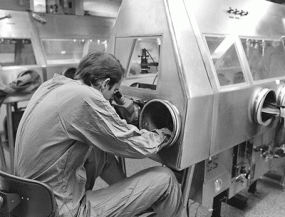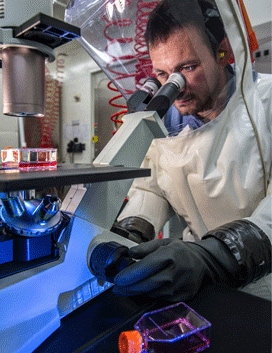High Containment Laboratories at CDC – Fifty Years of Excellence
This year marks the 50th anniversary of CDC’s rich history of laboratory work investigating the world’s deadliest pathogens.
In 1969, CDC opened its first permanent high-containment laboratory (HCL) to protect scientists while they worked with dangerous infectious pathogens. The original HCL was established in response to an outbreak of a new hemorrhagic fever reported in lab workers in Europe in 1967—it would come to be called Marburg virus and was eventually traced back to imported African green monkeys. The opening of CDC’s new lab also coincided with the emergence of another new pathogen in West Africa, Lassa fever, another viral hemorrhagic fever capable of causing severe illness in people. Over the next decade, additional viruses would be identified for work in this special lab, like Ebola.
For over 50 years, the design and construction of CDC’s HCLs have kept pace with advances in lab technology and research methods. CDC opened its second HCL in 1978, an expanded “hot lab” that incorporated positive-pressure suit technology. In 1989, CDC opened a new biosafety level (BSL)-4 facility, one of only two in the nation at the time. In 2008, CDC opened its current HCL building, which holds four BSL-4 suites, which are used to study viral hemorrhagic fevers, smallpox, and highly pathogenic strains of influenza. CDC is still one of only a handful of facilities in the United States with BSL-4 lab space capable of handling deadly pathogens for which there is no approved treatment or vaccine.

Dr. Russell Regnery manipulates a microscope through airtight glove portals while seated at a Class III cabinet in Building 9 in 1978.
Modern HCLs are outfitted with a wide variety of safety features that let scientists work in a secure environment that protects both laboratory personnel and the public. Staying abreast of new scientific innovation has allowed the CDC HCLs to play a vital role in investigating and responding to newly discovered infectious diseases. Recognizing the importance of keeping these facilities modern so that CDC can continue its highly specialized work and world-class leadership in laboratory science, Congress approved funding in 2018 to build a new state-of-the-art HCL as current systems begin to age. The new facility is scheduled to be operational in 2025.
With each new HCL facility, CDC has expanded the agency’s research capabilities, resulting in better understanding of mysterious pathogens, as well as the development of new tests to detect deadly diseases and improved treatments to help people survive. While CDC reflects on the successes of the past 50 years in the HCLs, we also look toward the future. In an increasingly mobile and connected world, the next outbreak is just a plane ride away. Thanks to cutting-edge research facilities like the HCLs—and the dedicated laboratory scientists who work in them—CDC remains vigilant, ready to respond.

A CDC scientist uses a microscope to monitor virus infection in cells grown in tissue culture flasks in the current HCL.